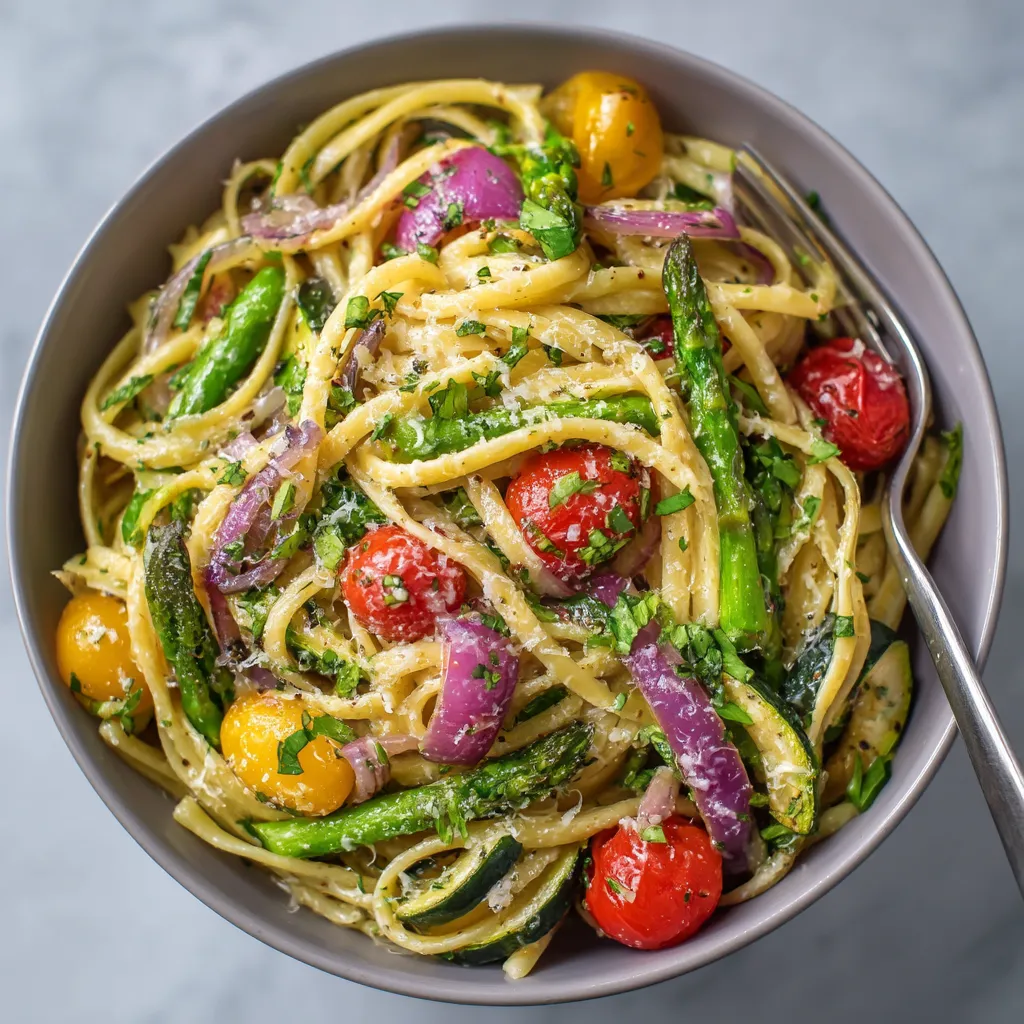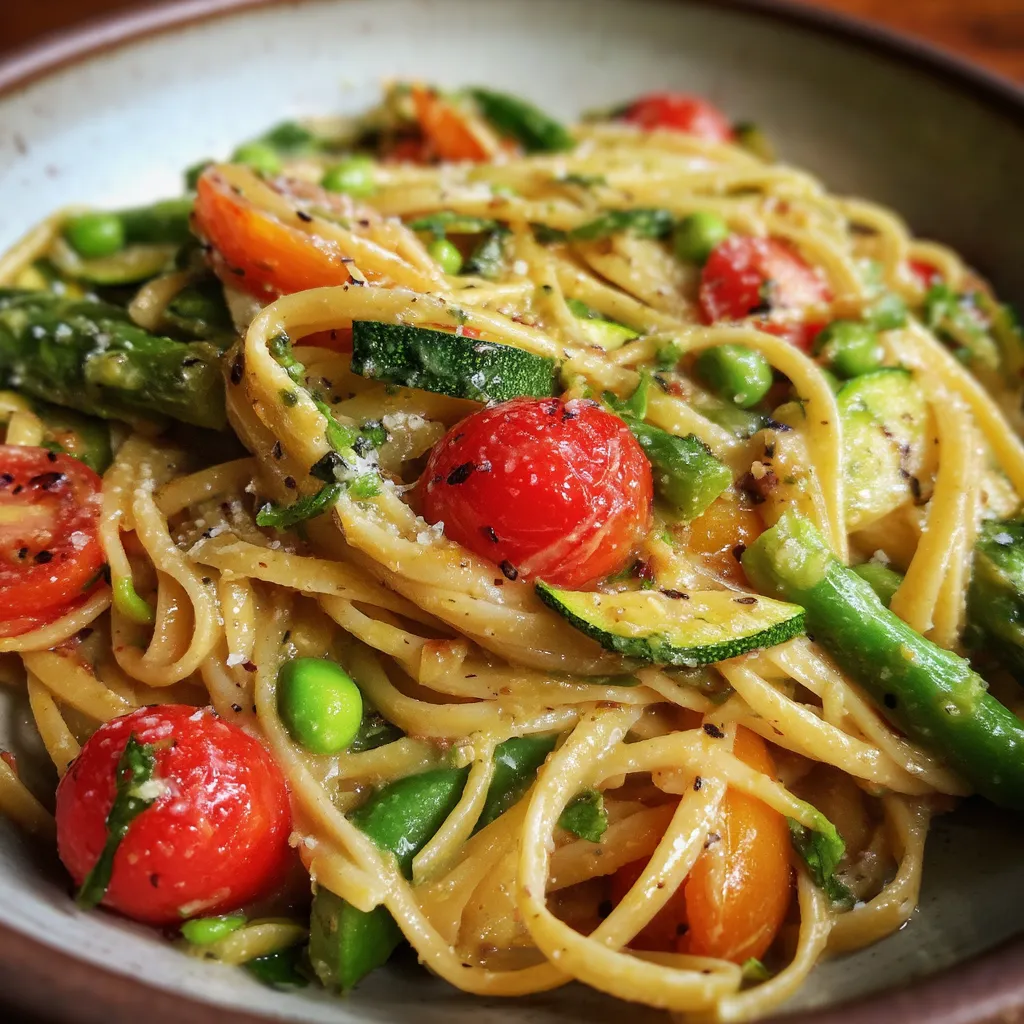 Save It
Save It This vibrant one-pot spring veggie pasta has become my go-to dinner for busy weeknights when I want something fresh and satisfying without a sink full of dishes. The tender spring vegetables and al dente pasta come together in a light, flavorful sauce that tastes like it took hours, not minutes.
I first created this recipe during a particularly hectic spring when my farmers market haul was threatening to spoil in the fridge. Now it's in regular rotation whenever fresh vegetables are abundant, and my family cheers when they see it coming to the table.
Ingredients
- Linguine or spaghetti: the long strands absorb the flavorful broth beautifully and create the perfect twirl on your fork
- Asparagus: look for bright green stalks with tightly closed tips for the freshest flavor
- Sugar snap peas: select plump pods with a slight crunch when bent
- Cherry tomatoes: choose ripe ones that give slightly when squeezed for perfect burst of sweetness
- Zucchini: smaller ones tend to have better flavor and fewer seeds
- Red onion: adds a gentle aromatic base that turns slightly sweet when cooked
- Garlic: fresh cloves provide much better flavor than pre-minced varieties
- Vegetable broth: becomes your pasta cooking liquid and creates the sauce
- White wine: adds complexity to the sauce but can be omitted
- Lemon: both zest and juice brighten the entire dish
- Parmesan cheese: use freshly grated for the best melting quality
- Butter: creates silkiness in the final sauce
- Fresh herbs like basil and parsley: add the finishing aromatic touch
Step-by-Step Instructions
- Create The Aromatic Base:
- Heat olive oil in your Dutch oven or large skillet over medium heat. Add the sliced red onion and minced garlic, cooking them gently for 2 to 3 minutes. You want them softened but not browned, as this creates the foundation of flavor for the entire dish. Stir frequently to prevent any burning.
- Start The Pasta:
- Add your dry linguine along with the vegetable broth, white wine if using, lemon zest, and a generous pinch of salt. Bring this mixture to a boil, which activates the starches in the pasta. The pasta will begin absorbing the flavorful liquid and releasing its own starches to create the base of your sauce.
- Simmer And Stir:
- Reduce the heat to maintain a gentle simmer and cook uncovered for about 6 to 7 minutes, stirring frequently. This prevents the pasta from sticking to the bottom and ensures even cooking. The liquid will begin to reduce and thicken slightly from the pasta starches.
- Add The Vegetables:
- Add the asparagus, zucchini, and snap peas to the pot. These vegetables need a bit more cooking time than the tomatoes. Continue cooking for another 5 to 6 minutes while stirring often. The vegetables should become tender but still maintain some texture, and the pasta should reach al dente perfection.
- Create The Sauce:
- Stir in the halved cherry tomatoes, butter, lemon juice, and Parmesan cheese. The residual heat will warm the tomatoes without making them mushy, while the butter and cheese melt to create a light, silky sauce that clings to every strand of pasta. Cook for just 1 to 2 more minutes until everything comes together.
- Finish With Fresh Herbs:
- Season with freshly ground black pepper and additional salt if needed after tasting. Remove from heat and fold in the fresh basil and parsley. The heat of the pasta will release the aromatic oils in the herbs without cooking away their fresh flavor and vibrant color.
 Save It
Save It My absolute favorite part of this dish is how the lemon zest permeates everything with its bright aroma. I discovered this trick when making this for my mother who adores citrus flavors. She declared it was the most springlike pasta she had ever tasted, and now I never skip this ingredient no matter what vegetables I include.
Perfect Vegetable Swaps
This pasta welcomes seasonal substitutions throughout the year. In early spring, try tender young spinach and English peas. Summer calls for bell peppers and corn kernels sliced right off the cob. Fall variations work beautifully with butternut squash cubes and kale ribbons. The technique remains the same regardless of your vegetable choices, though harder vegetables should be added earlier in the cooking process.
Make It Ahead
This pasta is ideal for meal prep but requires a special approach. Prepare the recipe as directed but remove it from heat when the pasta is just slightly underdone. Allow it to cool completely, then refrigerate in an airtight container for up to three days. When reheating, add a splash of broth or water and warm gently over medium-low heat, stirring occasionally. Add a fresh sprinkle of herbs and Parmesan just before serving to revive the flavors.
The History Behind One-Pot Pasta
This cooking method draws inspiration from the traditional Italian pasta technique of finishing pasta in its sauce, but takes it further by cooking everything together from the start. The approach gained popularity in the early 2010s when home cooks began seeking simpler methods that didn't sacrifice flavor. While purists might insist on cooking pasta separately, this method creates a uniquely flavorful result as the pasta absorbs the seasoned cooking liquid and vegetables release their flavors directly into the sauce.
 Save It
Save It Serving Suggestions
Serve this pasta as a complete meal on its own or alongside a simple green salad dressed with olive oil and lemon juice. For a more substantial dinner, add a protein like grilled shrimp or sliced grilled chicken on top. A glass of the same white wine used in cooking makes a perfect pairing. For a beautiful presentation, serve in wide, shallow bowls that showcase the colorful vegetables, and finish with a light grating of additional Parmesan and a few whole basil leaves.
Common Questions About Recipes
- → Can I use different vegetables in this pasta dish?
Absolutely! This dish is versatile and works well with whatever vegetables are in season. Try green peas, spinach, artichokes, broccoli, or bell peppers. The key is to add hardier vegetables earlier in the cooking process and more delicate ones toward the end.
- → How can I make this dish vegan?
To make this dish vegan, simply replace the butter with additional olive oil and substitute the Parmesan cheese with a plant-based alternative or nutritional yeast. The vegetable broth base already provides plenty of flavor.
- → Why cook pasta directly in the broth?
Cooking pasta directly in the broth serves multiple purposes: it infuses the pasta with flavor as it absorbs the liquid, creates a naturally starchy sauce without adding cream, and reduces cleanup since you only use one pot. The starch released from the pasta helps thicken the sauce.
- → Can I prepare this dish ahead of time?
This pasta is best enjoyed immediately after cooking when the texture is optimal. However, leftovers can be stored in an airtight container in the refrigerator for up to 2 days. When reheating, add a splash of water or broth to revive the sauce, as the pasta will continue to absorb liquid as it sits.
- → What can I substitute for white wine in the recipe?
If you prefer not to use white wine, simply replace it with an equal amount of additional vegetable broth. You can add a teaspoon of white wine vinegar or a bit more lemon juice to achieve a similar acidic brightness that wine provides.
- → How do I prevent the pasta from sticking together?
Stirring frequently is key to preventing the pasta from sticking, especially in a one-pot preparation. Make sure to use a large enough pot that gives the pasta room to move, and maintain a gentle simmer rather than a vigorous boil to help ingredients cook evenly.